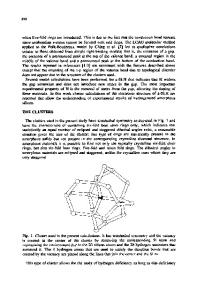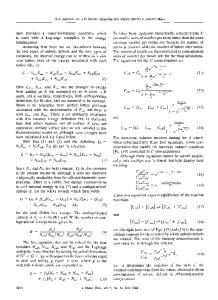First-Principles Calculations of Energetic Properties of Vacancies, Mn-Atomic Defects in CdTe
- PDF / 178,038 Bytes
- 6 Pages / 595 x 842 pts (A4) Page_size
- 27 Downloads / 348 Views
0959-M17-01
First-Principles Calculations of Energetic Properties of Vacancies, Mn-Atomic Defects in CdTe Ghouti Merad1, Benali Rerbal1, Hafid Aourag1, and Joël Cibert2 1 A. Belkaid University, LEPM, URMER, BP 119, Tlemcen, 13000, Algeria 2 CNRS, Laboratoire Louis Néel, BP 166, Grenoble, 38042, France ABSTRACT An atomistic model based on density functional theory within the framework of the local density approximation is used to show the trends in the energetic properties of single and double defects in CdTe semiconductor, without phase transformation. A systematic study of vacancies, Mn substituting Cd atoms in a supercell structure consisting of 16-atoms is presented. The changes of structural properties and lattice parameters due to the addition of Mn-atomic type defects in CdTe matrix are compared, and the number of vacancies is also determined from the total energy calculations. INTRODUCTION The introduction of dopants and residual impurity atoms, intrinsic defects, e.g. vacancies and interstitials, can strongly influence the optical and electrical properties of semiconductors and consequently have been a subject of intensive research [1, 2]. The incorporation of magnetic ions in diluted magnetic semiconductors (DMS), selfassembled quantum dots (QD’s) opens a new and interesting field in QD’s physics [3]. However, QD’s based on II-VI semiconductors compounds offer the unique possibility of incorporation magnetic ions (Mn2+) isoelectronically into the crystal matrix [4]. Mn2+ ions are built substitutionally into cation sites of the host II-VI lattice Cd or Zn either zinc-blende structure [5-9]. The existence of vacancies in semiconductors compounds plays an important role for their kinetic and thermodynamic properties. Certainly large defects like grain boundaries and longranged dislocations are important, but even one of the simplest defects: the lattice vacancy can be responsible for a variety of phenomena such as trapping of impurities and vacancymediated dopant diffusion. Moreover, it is possible to introduce single Mn atoms into CdTe/ZnTe QD’s during their growth by Molecular Beam Epitaxy (MBE), adjusting the density of Mn atoms to be roughly equal to the density of the dots [3]. Experiments are able to find the total diffusion coefficient, but they generally cannot determine the microscopic diffusion mechanism [10]. A prerequisite to the understanding of dopant diffusion is the mechanism of diffusion in semiconductors. Thus, Mn atoms are believed to diffuse in Cd sites by a mechanism involving a vacancy in the CdTe lattice. However, in order to determine an accurate model of the dopant diffusion under conditions influenced by externally created defects, it is important to know the atomic parameters governing point defects energetic. The attempt of the present work is to present a systematic study of the Mn-atomic type defects addition and vacancies in the CdTe semiconductor from quantum mechanical calculations based on the density functional theory (DFT). To this purpose, we have used the full-potential l
Data Loading...










